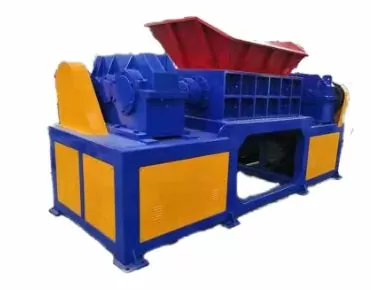Plastic pallets—strong, bulky, and annoyingly hard to get rid of. I’ve met countless recycling plant managers scratching their heads over mountains of them. The problem? They take up valuable warehouse space, and regular crushers just bounce off them. That’s the pain. The agitation? They’re too valuable to waste, but too tough to process easily. The solution? Yes—you can shred plastic pallets efficiently, but only if you know how to choose the right machine and approach.
Yes, you can shred plastic pallets. The key lies in using an industrial-grade plastic shredder designed for dense materials like HDPE and PP. With the right rotor speed, torque, and blade design, shredding plastic pallets becomes an efficient step toward recycling or reusing plastic waste.
If you’ve ever tried shredding one with the wrong equipment, you know—it’s like throwing a helmet into a blender. Let’s break it down so you never have to learn that lesson the hard way.

What makes plastic pallets so hard to shred?
Plastic pallets are usually made from high-density polyethylene (HDPE) or polypropylene (PP). These plastics are incredibly durable and resistant to impact, chemicals, and moisture. That’s great for logistics, but not so great when you want to shred them.
A typical HDPE pallet can weigh 15–25 kg and is reinforced with ribs for strength. This rigidity makes them bounce or jam in weak shredders. According to a report from the Two Shaft Shredder For Chemical Drum, the tensile strength of HDPE used in pallets exceeds 30 MPa—stronger than many types of soft wood.
What kind of shredder can handle plastic pallets?
This is where industrial plastic shredders, like the ones we build at Amige Machinery, come in. We design shredders that don’t just “cut” plastic—they tear it apart with precision and torque.
For plastic pallets, I usually recommend a double-shaft shredder or a single-shaft shredder with a hydraulic pusher. The double-shaft model uses two counter-rotating blades to grab and shear large chunks of plastic. It’s like a pair of robotic jaws—steady, patient, and unstoppable.
Check out this technical breakdown from Industrial Shredder Benchmark Report 2025for efficiency comparisons between shredder types.
Why is shredding plastic pallets important?
Let’s be blunt: unshredded plastic pallets are logistical nightmares. They take up space, cost money to store, and are often too bulky to transport efficiently.
By shredding them, we reduce their volume by up to 85%, according to Single shaft shredder 1200mm for HDPE pallet recycling. This means lower transport costs, easier washing and drying, and simpler downstream recycling. Plus, shredded plastic flakes can be regranulated to make new pallets, pipes, or even furniture.
Can any shredder process both wood and plastic pallets?
A good question I hear often. In theory, yes—but in practice, no. Wood and plastic behave differently under stress.
Plastic bends and resists, while wood splinters and breaks. Machines optimized for one often struggle with the other. Dual-purpose shredders exist, but they require variable speed control and interchangeable blades.
When clients ask if they can use one shredder for both, I usually say: “You can—but you’ll shorten its life.” Always better to have a specialized setup if you handle both materials regularly.
How do I choose the right shredder for plastic pallets?
Here’s my checklist, refined from years in the field:
- Material type – Know if your pallets are HDPE or PP.
- Capacity – Estimate daily output. Start from 300–1000 kg/h.
- Output size – Choose your screen mesh depending on downstream use.
- Motor power – Go for high torque over high speed.
- Blade material – Opt for D2 or SKD11 steel for durability.
- Maintenance access – Always pick a machine that’s easy to clean and repair.
For instance, our Amige single-shaft series integrates a hydraulic pusher to prevent blockages—a simple but crucial feature when shredding thick plastic pallets.
How to process shredded plastic pallets after shredding?
Once shredded, the plastic flakes usually go through:
- Washing – To remove dirt or residues.
- Drying – Hot air or centrifugal drying systems.
- Granulation – Regrinding into uniform pellets.
- Extrusion – For making new products or sheets.
The key is consistent flake size, which improves granulation quality. According to Double Shaft Shredder Machine, consistent flake geometry can improve extrusion throughput by 25%.
Can shredded plastic pallets be reused or recycled profitably?
Absolutely. The global recycled HDPE market is growing rapidly, with prices averaging $0.85 per kg in 2025, as reported by Polymer Trade Index.
Shredded pallet material can be:
- Remolded into new pallets
- Converted into drainage pipes
- Used in outdoor furniture
- Processed into plastic lumber
The return on investment for a pallet shredding setup can often be achieved within 8–12 months, depending on volume and logistics.
What safety considerations should I keep in mind?
Shredding thick plastics isn’t a quiet job. It’s a power game. Always ensure:
- The shredder is equipped with overload protection.
- Operators wear ear protection and gloves.
- The machine includes an emergency stop system.
- Regular maintenance is scheduled to prevent overheating.
A clogged shredder can lead to blade breakage, which is costly and dangerous. I’ve seen clients neglect safety for speed—always a bad trade.
What’s the future of plastic pallet shredding?
Automation is leading the way. Modern shredders now integrate AI-based feeding control, torque sensors, and real-time monitoring for predictive maintenance.
At Amige, we’re exploring modular shredder systems that can scale up production without replacing the entire setup. That means lower capex and smarter maintenance scheduling. Efficiency, after all, is profit’s best friend.
Conclusion
Yes, plastic pallets can—and should—be shredded. With the right shredder, the right setup, and a little know-how, what was once waste becomes a new resource stream. Recycling isn’t just green; it’s smart business.
